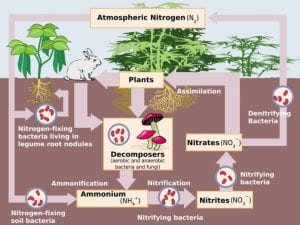Everyone is concerned about the high cost of fertilizer, so let’s strive to get the most from each dollar spent. We also know that nitrogen is a very mobile nutrient as shown in the graphic above depicting the nitrogen cycle (source). N can be lost to the atmosphere or through leaching depending on timing, source, or method of application, One loss, typical of surface applied unprotected urea, is by the conversion of urea to ammonia through an enzymatic breakdown lead by microbes. The enzyme that breaks down urea is called urease (which converts urea to ammonia). Nitrification is the transformation of soil stable ammonium (NH4+) to nitrate (NO3) which is a 2-step process driven by microbes; first to nitrite (NO2) and then to nitrate, which is available for plant uptake. Denitrification is the loss of N when nitrite converts to N gas in waterlogged soils. Nitrate can be lost by leaching. (Both ammonium and nitrate are available for plant uptake).
We need to match our use and application with the mode of action for protection to select the product that matches the potential cause of loss. The article that follows from the University of Nebraska explains the products, how they work, and whether they pay for themselves.
R.L Nielsen. Purdue University Agronomist provides some guidance…
“Inhibitors vs. Sidedress
Urease inhibitors (used with urea or UAN solutions), nitrification inhibitors (used primarily with anhydrous ammonia), or polymer-coated urea represent various forms of nitrogen loss “insurance” that add cost to your nitrogen management program. Like any insurance policy, the policy will “pay off” only if conditions are suitable for N loss to occur prior to plant uptake. Another strategy to manage the risk of N loss is sidedress apply your fertilizer N instead of applying it pre-plant. The main reason that sidedress N applications will be more efficient in the “long haul” is that there is a shorter calendar “window” between application and plant uptake for sidedress than for pre-plant applications. The shorter time period means there are fewer opportunities for heavy rainfall events and nitrate-N loss; and thus NUE (nitrogen use efficiency) will be greater on average. Sidedress applications often do not add dollar cost to your fertilizer program, but obviously, alter the logistics of your farming operation and are more at risk from rainy weather prior to “too tall” corn.
In Summary… One of the keys to managing costs of nitrogen fertilizer or maximizing nitrogen use efficiency is to manage N sources wisely to minimize the risk of nitrogen loss due to leaching, denitrification, or volatilization. The use of a sidedress application strategy remains one of the easiest and least expensive ways to maximize nitrogen use efficiency. Other application methods and timings need to be matched wisely to nitrogen fertilizer sources to minimize the risk of nitrogen loss prior to plant uptake.
Source: N Loss Mechanisms and Nitrogen Use Efficiency R.L. (Bob) Nielsen, Purdue Agronomy. rnielsen@purdue.edu. 2006NLossMechanisms_Neilsen Purdue.pdf

